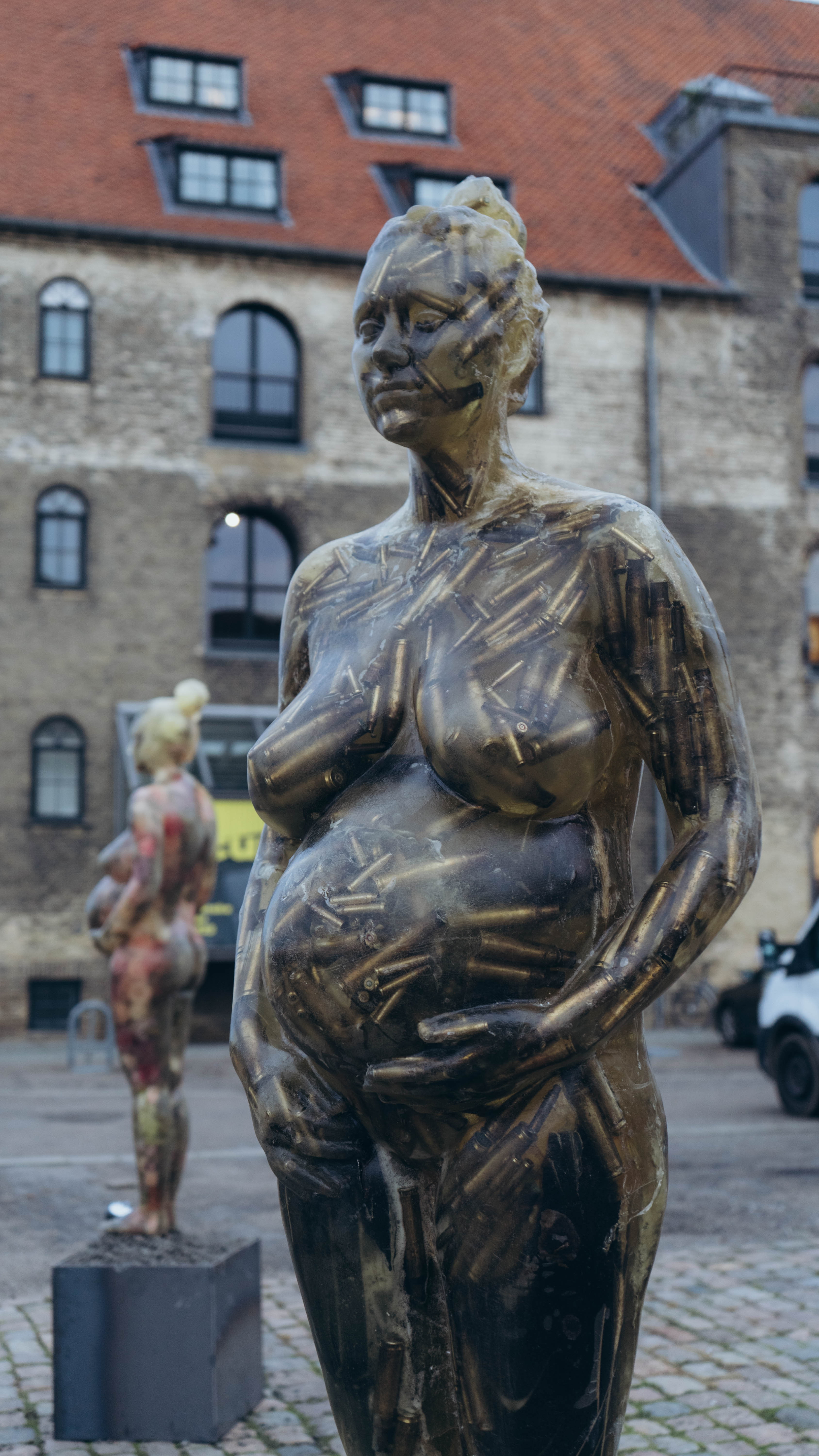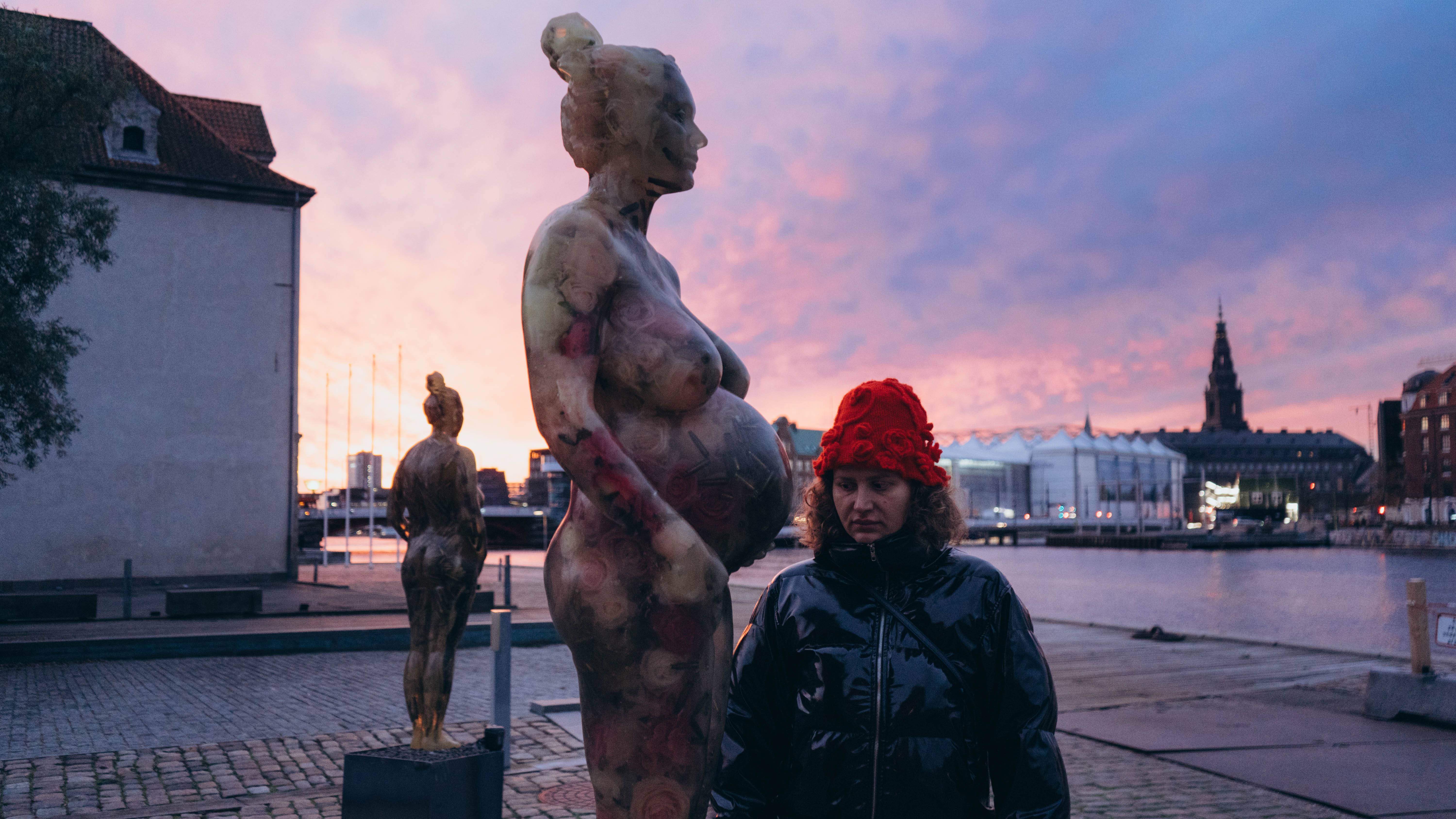November 18 - December 26, 2025
Waterfront by Ukraine House, Copenhagen, Denmark
November 18 - December 26, 2025
Waterfront by Ukraine House, Copenhagen, Denmark
Organized by Spline Art. This exhibition has been made possible through the support of Ukrainian businesses Ajax Systems and MHP, and the state leadership of Tetyana Berezhna and the Ministry of Culture

This exhibition, organized by Spilne Art and Ukrainian House in Denmark, Copenhagen, marks a new chapter in Kulykivska’s long-term artistic exploration of the body as both witness and territory of war - a battlefield where vulnerability transforms into strength, and where destruction gives way to renewal.
In her series of Pregnant Figures “After Death Comes Life”, body casts made from the artist’s own form contain bullet casings, mine fragments, and dried flowers from Ukrainian fields - symbols of pain, resilience, and rebirth. These works speak of life that continues to grow even on scorched ground.
Earlier in November, at the Meeting of Ministers of Culture from over 40 countries in Copenhagen, Spilne Art presented works by Mariia Kulykivska, contributing to the international dialogue on cultural resilience and the protection of Ukrainian heritage. During the same event, Minister Tetyana Berezhna introduced the Ukrainian Cultural Heritage Fund (UCHF), supported by initial contributions of over €3 million. The public exhibition of Mariia Kulykivska in Copenhagen became a natural continuation of this cultural presencе, reinforcing a shared commitment to strengthening Ukraine’s cultural voice worldwide.
Spilne Art founder Nataliia Tkachenko represented the project during the forum, participating in cultural diplomacy discussions dedicated to protecting Ukrainian heritage and promoting Ukraine’s voice. Kulykivska’s art, met with deep respect at the forum, became an emotional focal point in the dialogue about shared European values and collective responsibility for the future.
Acknowledgements:
This exhibition has been made possible through the support of Ukrainian businesses Ajax Systems and MHP, and the state leadership of Tetyana Berezhna and the Ministry of Culture and Information Policy of Ukraine. Their partnership exemplifies how collaboration between the state, art, and business strengthens Ukraine’s cultural voice internationally.

“I collect and dry herbaria – my home is filled with plants that carry symbolic meaning for me.”
In February, around Maria’s birthday, she returned to Kyiv after two years of living in exile across Europe. As a gift to herself, she decided to undergo a full medical examination. At that time, her physical and psychological state was extremely fragile; she could barely walk and was living under the shadow of a possible cancer diagnosis. Later, it turned out that it was not cancer, but a pre-diabetic condition provoked by severe emotional stress – the body had simply reached its limit. That evening, following her intuition, she ordered a large number of roses. “My entire room was covered in them,” she recalls. “I started drying them – not only for myself but also for my mother, as a kind of celebration of life, because I didn’t know if I would survive.” Soon after, she read the devastating news that Yan Kvylinskyi – Ukraine’s leading rose breeder, founder of Kvylinskyi’s Garden, who even developed new rose varieties named after his wife – had been killed on the battlefield in January 2024 while defending Avdiivka. His wife later closed the family business, unable to bear the loss. By coincidence, Maria became one of the last people to buy those roses – flowers that no longer exist. “I didn’t add a single artificial flower,” she says. “Only the dried ones. And something happened: they began to burn from within, turning into small coals.” The sculpture became gray and somber, its surface marked with tiny holes that the artist tried to seal to keep the flowers from rotting. From afar, they look like decomposed matter, but upon closer view, one can still see the delicate translucence of petals. This is a memorial sculpture – a quiet requiem to fragility, death, and the continuity of beauty.
This figure carries within it the residues of the artist’s earlier work, the remnants of a soap sculpture she created for the National Fine Arts Museum in Odesa in 2019. Back then, she could only use artificial flowers; real ones wilted too quickly. Those same artificial roses remained with her, silent witnesses of an earlier self, an earlier grief. “At the time,” she recalls, “that sculpture was the saddest work I had ever made. But even that sadness cannot compare to the one I feel now.” In the new, this time pregnant sculpture, Maria decided to return to those flowers – not as decoration, but as vessels of memory. Unlike before, she infused them with what she calls a “gentler energy”, an attempt at reconciliation, at quiet joy, at life continuing despite everything. Roses thus becomes a dialogue between two timelines of the same body: the woman she once was and the woman who continues to survive. The artificial roses, once symbols of imitation, now serve as fragile mediators between authenticity and artifice, loss and rebirth. Here, flowers no longer simply adorn the body; they become the body. They hold within them all the layers of life that persist after death; layers that ache, rot, glow, and continue to transform.
This work reflects on the events of 2023/2024, when Ukrainian farmers’ products were blocked at the Polish border - an act that evoked, for Maria, memories of the collective, transgenerational trauma of the Holodomor. She recalls her grandmother’s stories and how she could never pass by abandoned ears of wheat lying on the road without grief. The wheat used in this piece was collected in her mother’s village. The artist embedded it into the sculpture’s chest and abdomen, together with fragments of exploded mines, bomb shards, and large shell casings sent anonymously from Izium, Bakhmut, and Avdiivka. These remnants of war became part of the sculpture’s internal skeleton – a literal and symbolic embodiment of endurance and transformation. “When I poured epoxy resin over the wheat,” says Maria, “a chemical reaction began – corrosion, and the sculpture darkened, becoming heavy, dirty, melancholic.” Here, life and death are inseparable: fertility and decay merge into a single body of memory.